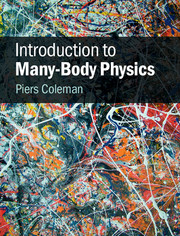Book contents
- Frontmatter
- Dedication
- Contents
- Preface
- Introduction
- 1 Scales and complexity
- 2 Quantum fields
- 3 Conserved particles
- 4 Simple examples of second quantization
- 5 Green's functions
- 6 Landau Fermi-liquid theory
- 7 Zero-temperature Feynman diagrams
- 8 Finite-temperature many-body physics
- 9 Fluctuation–dissipation theorem and linear response theory
- 10 Electron transport theory
- 11 Phase transitions and broken symmetry
- 12 Path integrals
- 13 Path integrals and itinerant magnetism
- 14 Superconductivity and BCS theory
- 15 Retardation and anisotropic pairing
- 16 Local moments and the Kondo effect
- 17 Heavy electrons
- 18 Mixed valence, fluctuations, and topology
- Epilogue: the challenge of the future
- Author Index
- Subject Index
- References
Epilogue: the challenge of the future
Published online by Cambridge University Press: 05 December 2015
- Frontmatter
- Dedication
- Contents
- Preface
- Introduction
- 1 Scales and complexity
- 2 Quantum fields
- 3 Conserved particles
- 4 Simple examples of second quantization
- 5 Green's functions
- 6 Landau Fermi-liquid theory
- 7 Zero-temperature Feynman diagrams
- 8 Finite-temperature many-body physics
- 9 Fluctuation–dissipation theorem and linear response theory
- 10 Electron transport theory
- 11 Phase transitions and broken symmetry
- 12 Path integrals
- 13 Path integrals and itinerant magnetism
- 14 Superconductivity and BCS theory
- 15 Retardation and anisotropic pairing
- 16 Local moments and the Kondo effect
- 17 Heavy electrons
- 18 Mixed valence, fluctuations, and topology
- Epilogue: the challenge of the future
- Author Index
- Subject Index
- References
Summary
On October 19, 2014, as I finished this book, a group of physicists convened at the University of Illinois Urbana-Champaign, home of BCS theory [1], to mark 60 years of progress in strongly correlated electron systems (SCES) and to celebrate the 90th birthday of David Pines. This occasion provided a great opportunity for us to reflect on the dizzying progress of the past 60 years of discovery in many-body physics: a period that spans from the Bohm–Pines plasmon theory of metals [2–4], the discovery of Landau Fermi-liquid theory [5], and BCS theory [1], to the modern era of topological order, strange quantum-critical metals, and high-temperature-superconductivity. This book has only scratched the surface of this period, leaving out some key aspects of the field that I perhaps will go into in a future edition. Yet still, almost everything in this book was unknown 60 years ago. The pioneers of early many-body physics in the 1950s simply could not have imagined the revolution of discovery that has since taken place. David Pines recalls thinking, as a graduate student in the early 1950s, that the physicists 20 years earlier had had all the luck. Yet Pines' thesis work with Bohm marked a beginning of 60 years of tremendous discovery.
You, the reader, might be tempted to think as David Pines did. However, at the “60 years of SCES” meeting in Urbana, many expressed remarkable optimism that the revolution is decidedly unfinished, and that the next 60 years has much in store. Like earthquakes, big scientific discoveries are unpredictable and come at varying intervals. Today, in the early twenty-first century, a large number of unsolved mysteries and problems in condensed matter physics provide the tremors that suggest that there is much yet to discover. I thought it would be interesting, if only as a historical record, to list a few of the challenges we all face:
1 Wanted: a broader understanding of the classes of emergent order in condensed Matter. Between the many decades of complexity that separate simple elements from primitive life surely lie many layers of emergent material behavior. The possibility of new forms of order, as challenging and surprising as superconductivity, cannot be ruled out.
- Type
- Chapter
- Information
- Introduction to Many-Body Physics , pp. 787 - 789Publisher: Cambridge University PressPrint publication year: 2015

